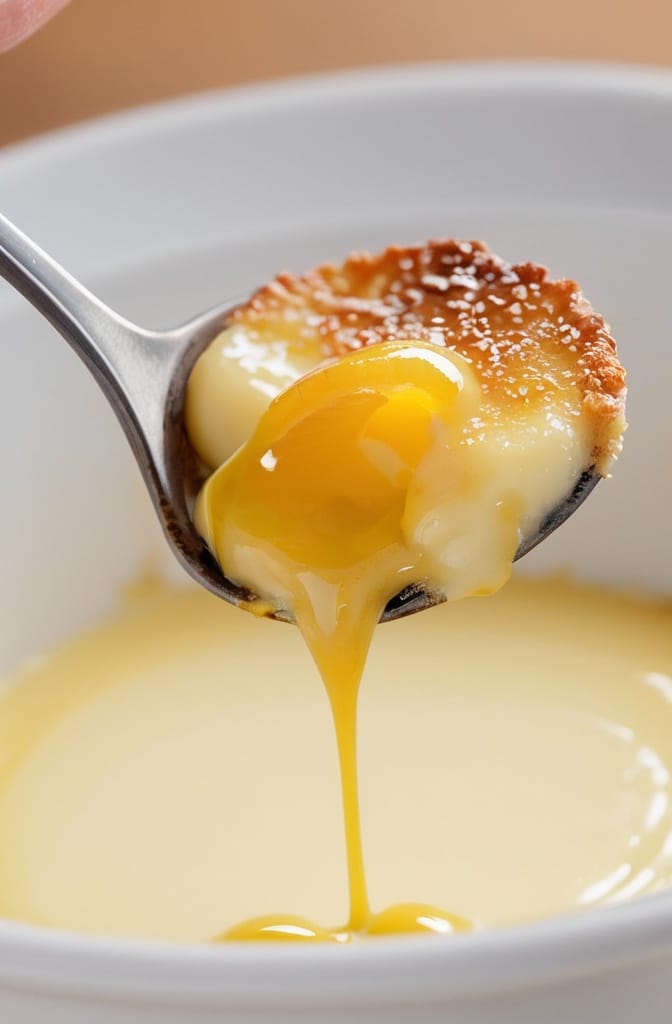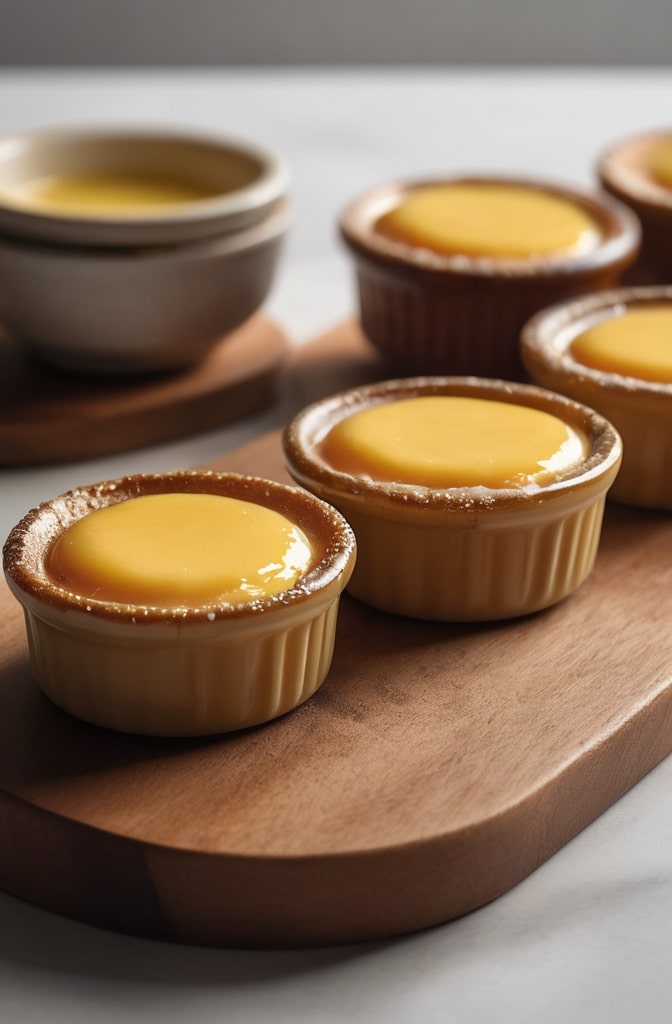The first time I watched a pastry chef crack through the glassy caramelized sugar atop a crème brûlée, I was mesmerized. That delicate “tap-tap-crack” sound still gets me every time. But nothing compares to the magic of a Lemon Curd Crème Brûlée Treat. Introducing bright, tangy lemon curd to this classic French dessert transforms something familiar into an experience that makes your taste buds stand at attention.
I’ve spent years perfecting this particular fusion, and I’m thrilled to share it with you. It’s not just another dessert it’s an elegant statement that balances richness with acidity in a way that few other desserts can achieve.
What Makes This Recipe Special
This lemon curd crème brûlée isn’t just showing off. It’s a thoughtful marriage of two distinct dessert traditions that complement each other perfectly. The silky, custard base provides a luxurious canvas for the bright, zesty lemon curd, while the crackling sugar top adds that essential textural contrast we all crave.
What really makes this desert stand out is how the heat from torching the sugar slightly warms the lemon curd beneath, creating a temperature gradient that enhances the sensory experience. It’s sophisticated enough for a fancy dinner party but approachable enough that anyone with some patience can master it.
Ingredients & Substitutions
For the Crème Brûlée Base:
- 6 large egg yolks (room temperature)
- 500ml heavy cream (36% fat content)
- 1 vanilla bean, split and scraped (or 2 tsp pure vanilla extract)
- 100g granulated sugar
- Pinch of salt
- Additional granulated sugar for the caramelized topping
For the Lemon Curd:
- 4 large lemons (you’ll need zest and 120ml juice)
- 150g granulated sugar
- 4 large eggs
- 115g unsalted butter, cubed and cold
- 1/4 tsp salt
I’m gonna be straight with you—the egg yolks are non-negotiable here. They’re the structural backbone of both components. However, if you’re avoiding dairy, coconut cream can substitute for heavy cream in the custard base, though it will impart a subtle coconut flavor that actually pairs beautifully with the lemon.
For the lemon curd, Meyer lemons create a more delicate, less acidic result when they’re in season. Regular lemons work brilliantly year-round. If you’re feeling adventurous, try swapping half the lemon juice with passionfruit pulp for an exotic twist.
The quality of your vanilla matters enormously. A real vanilla bean with those gorgeous specks elevates this dessert from good to memorable. Those tiny black dots aren’t just for show—they’re bursting with complex flavor compounds that artificial vanilla simply can’t replicate.
Step-by-Step Instructions

Making the Lemon Curd
- Begin by zesting your lemons carefully, avoiding the bitter white pith. In a heatproof bowl, rub the zest vigorously into the sugar with your fingertips until the sugar becomes moist and fragrant—this releases the essential oils that carry intense flavor.
- Add eggs to your sugar-zest mixture and whisk until well combined but not frothy (we’re not making meringue here). Then add the lemon juice and salt, whisking again to incorporate.
- Place the bowl over a pot of barely simmering water (double-boiler method), making sure the bottom doesn’t touch the water. Whisk constantly—and I mean constantly—until the mixture thickens enough to coat the back of a spoon, about 10-12 minutes at 170°F (77°C). Remove from heat and immediately whisk in the cold butter, a few cubes at a time, waiting for each addition to melt before adding more.
Don’t rush this process! The gradual thickening is crucial, and if you crank up the heat hoping to speed things up, you’ll end up with sweet lemon scrambled eggs. If disaster strikes and you notice curdling, immediately remove from heat and strain through a fine-mesh sieve while whisking vigorously.
Once your curd is silky smooth, strain it through a fine-mesh sieve to remove the zest and any cooked egg bits. Press plastic wrap directly onto the surface (preventing that annoying skin from forming) and refrigerate for at least 2 hours or up to 2 days.
Preparing the Crème Brûlée Base
- Preheat your oven to 325°F (165°C) and prepare a water bath by placing a kitchen towel in the bottom of a large roasting pan. The towel prevents the ramekins from sliding around and helps them heat evenly.
- In a heavy-bottomed saucepan, combine the cream and vanilla bean (if using). Heat over medium-low until small bubbles form around the edges—don’t let it boil! Remove from heat, cover, and let steep for 15 minutes to infuse the vanilla flavor.
- In a large bowl, whisk together the egg yolks, sugar, and salt until pale and slightly thickened. The mixture should fall from the whisk in a thick ribbon. Remove the vanilla bean pod from the cream, then very gradually add the warm cream to the egg mixture, whisking constantly to prevent the eggs from cooking.
Many recipes underestimate how critical this tempering process is. If you dump all the hot cream in at once, you’ll end up with sweet scrambled eggs instead of silky custard. Take your time here—it’s worth it.
Once fully combined, strain the custard through a fine-mesh sieve to ensure ultra-smooth texture. At this point, if you’re using vanilla extract instead of a bean, stir it in.
Assembly and Baking
- Place 6-8 ramekins (depending on size) on the towel-lined roasting pan. Spoon about 2 tablespoons of lemon curd into the bottom of each ramekin, spreading it evenly.
- Carefully pour the custard mixture over the lemon curd, filling each ramekin nearly to the top. Be carefull not to disturb the curd layer too much—we want distinct layers.
- Pour hot (not boiling) water into the roasting pan until it reaches halfway up the sides of the ramekins. Bake in the preheated oven for 30-35 minutes, until the custards are set but still have a slight wobble in the center when gently shaken.
The water bath is non-negotiable—it ensures gentle, even heating that prevents the custard from curdling or developing a rubbery texture. Think of it as the dessert equivalent of a spa treatment.
Once baked, carefully remove the ramekins from the water bath and allow them to cool completely at room temperature. Then, cover each with plastic wrap and refrigerate for at least 4 hours, preferably overnight. This resting period allows the flavors to meld and the texture to perfect itself.
The Finishing Touch
- About 30 minutes before serving, remove the ramekins from the refrigerator to take the chill off slightly. This ensures the custard isn’t ice-cold when served, which would mute its delicate flavors.
- Just before serving, sprinkle each custard with a thin, even layer of granulated sugar (about 1-2 teaspoons per ramekin). Rotate the ramekin while sprinkling to get even coverage.
- Torch the sugar with a kitchen torch, moving the flame continuously across the surface until the sugar melts and caramelizes to a deep amber color. If you don’t have a torch, place the ramekins under a very hot broiler for 1-2 minutes, watching carefully to prevent burning.
Let the caramelized sugar cool and harden for about 2 minutes before serving. This creates that perfect, crackable crust that makes crème brûlée so satisfying.
Cooking Techniques & Science
Understanding the science behind this dessert helps achieve perfection. The custard base relies on a delicate balance of fat, sugar, and protein coagulation. Egg yolks begin to set at around 158°F (70°C), but the added fat from the cream raises this temperature and creates a smoother texture by interrupting protein networks.
The water bath (bain-marie) is crucial becus it limits the maximum temperature the custard can reach to 212°F (100°C)—the boiling point of water. This gentle cooking environment prevents the eggs from curdling and gives you that perfect silky texture.

For the lemon curd, we’re essentially creating an emulsion where fat (butter) is suspended in an acidic medium (lemon juice). The eggs act as the emulsifier, helping these naturally opposing ingredients play nicely together. The acid in the lemon juice also denatures the egg proteins, causing the mixture to thicken even before the heat is applied.
When torching the sugar, you’re actually causing caramelization and the Maillard reaction simultaneously. The sugar first melts, then undergoes structural changes that create hundreds of new flavor compounds. This transformation happens best around 320°F (160°C), which is why a torch is ideal—it provides intense, localized heat without warming the custard beneath.
Serving & Pairing Suggestions
This dessert deserves thoughtful presentation. Serve it on small plates with a sprig of fresh mint or a few seasonal berries for color contrast. A thin, crisp shortbread cookie on the side provides textural counterpoint and a vehicle for scooping up every last bit.
For a truly memorable experience, pair this dessert with a glass of Sauternes or a late-harvest Riesling, whose honey notes complement the caramelized sugar while the acidity balances the richness. Alternatively, a well-brewed Earl Grey tea works beautifully—the bergamot notes enhance the citrus elements of the dessert.
For an elevated dinner party presentation, consider making this in shallow, wider ramekins rather than the traditional deep ones. This provides more surface area for that glorious caramelized top layer and makes for a more dramatic table presentation.
Variations to Consider
Once you’ve mastered the basic recipe, consider these sophisticated variations:
- Herbal Infusion: Steep fresh thyme or lightly crushed lavender in the cream during the infusion stage for an elegant herbal note that complements the lemon beautifully.
- Citrus Medley: Replace half the lemon juice with blood orange or grapefruit juice for a more complex citrus profile. Each citrus brings its own unique balance of sweetness and acidity.
- Black Tea Infusion: Add 2 teaspoons of Earl Grey tea leaves to the cream during the steeping process to infuse a subtle bergamot flavor that pairs exquisitely with the lemon.
- Textural Contrast: Layer a thin sheet of brûléed sugar between the lemon curd and custard for an extra hidden crunch that surprises and delights.
Troubleshooting Common Issues
Even experienced pastry chefs encounter challenges with this dessert. Here are solutions to common problems:
- Weeping custard: If liquid seeps out after cutting into the custard, it was likely overcooked. Next time, remove it from the oven when still slightly jiggly in the center.
- Soft crust: If your caramelized sugar doesn’t harden properly, either your layer was too thin or the sugar was damp. Make sure to blot any condensation from the custard’s surface before adding sugar.
- Curdled lemon curd: If your curd develops a grainy texture, it was likely heated too quickly. Rescue it by immediately straining and blending with an immersion blender while still warm.
- Eggy flavor: This typically comes from overcooking. The custard should never exceed 180°F (82°C) internally, and using the water bath helps prevent this.
Conclusion
Creating this lemon curd crème brûlée is more than following a recipe—it’s about understanding the principles behind each component and how they work together. The contrast between the silky, vanilla-infused custard and the bright, tangy lemon curd creates a dessert greater than the sum of its parts.
The real magic happens in those quiet moments: the patient stirring of the curd, the gentle baking in the water bath, the breathless anticipation as you crack through that paper-thin caramelized crust. These are the rituals that connect us to centuries of pastry tradition while creating something uniquely our own.
Master this recipe, and you’ve gained more than just another dessert in your repertoire—you’ve gained an understanding of egg-based custards that will serve you across countless other preparations. And more importantly, you’ve created something truly memorible that celebrates the beautiful complexity possible in seemingly simple ingredients.
FAQs About Lemon Curd Crème Brûlée Treat
Can I make this dessert ahead of time?
Absolutely! The custards with lemon curd can be prepared up to 2 days in advance and kept refrigerated. Just hold off on the caramelized sugar topping until right before serving, as it will soften and lose its crackable texture if done too far ahead.
Why did my custard curdle during baking?
Curdling typically occurs when the custard gets too hot, too quickly. Always use a water bath, ensure your oven is properly calibrated, and check for doneness early. Remember, the custard should still have a slight wobble in the center when you remove it from the oven—it will continue to set as it cools.
Can I use a broiler instead of a kitchen torch?
Yes, though with some caveats. Chill the custards thoroughly first, place them on a baking sheet, and broil for just 1-2 minutes, watching constantly. The broiler heats the entire dessert more than a torch would, so your timing is crucial to prevent the custard from melting.
How do I know when my lemon curd is thick enough?
The perfect lemon curd should coat the back of a wooden spoon and hold a clear line when you run your finger through it. Temperature-wise, it should reach 170°F (77°C) for both food safety and proper thickening. If you’re uncertain, err on the side of slightly thicker rather than too thin.
Can I freeze these crème brûlées?
While technically possible, freezing isn’t ideal. The texture of both the custard and curd can become compromised upon thawing. If you must freeze them, do so before adding the sugar topping, thaw overnight in the refrigerator, and then brûlée just before serving.

